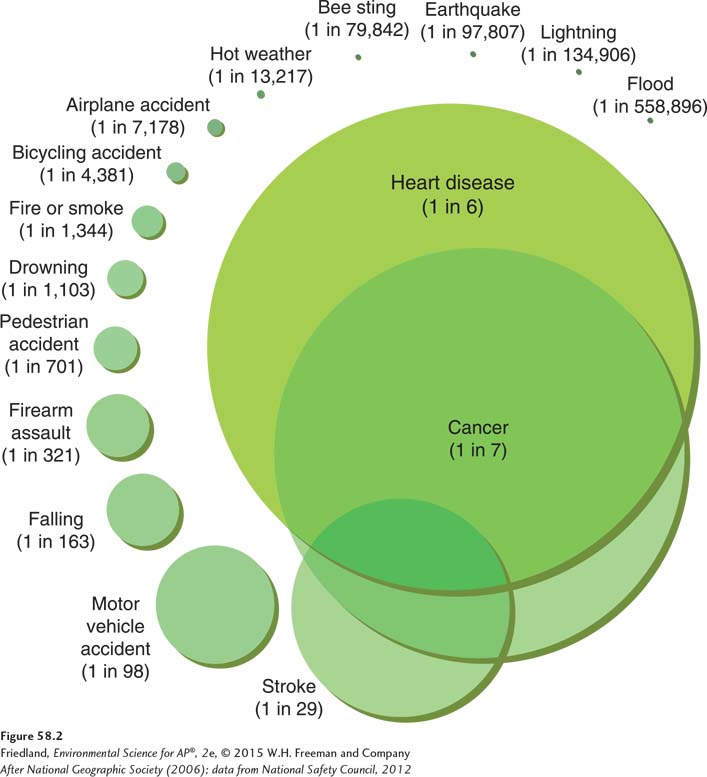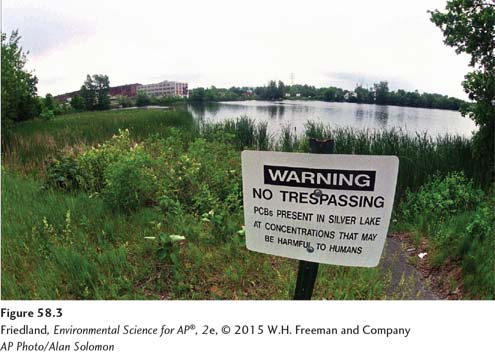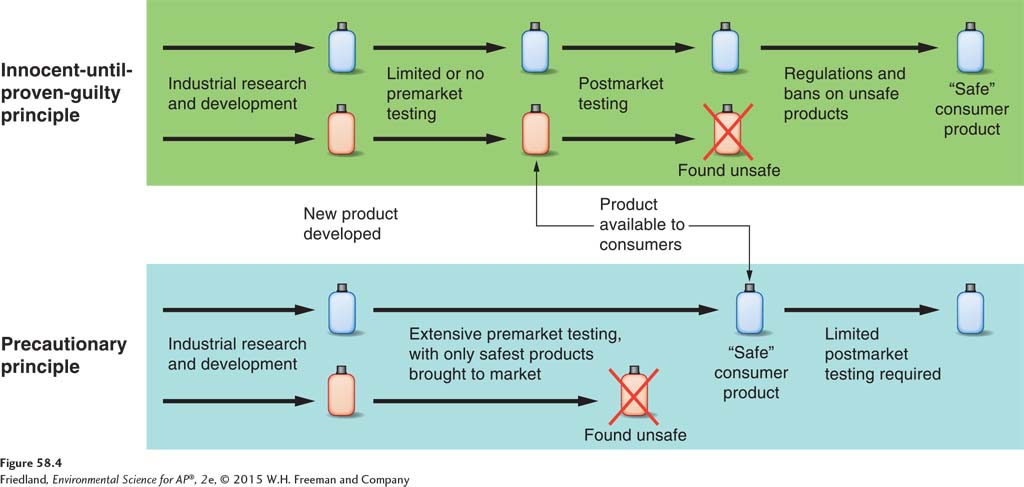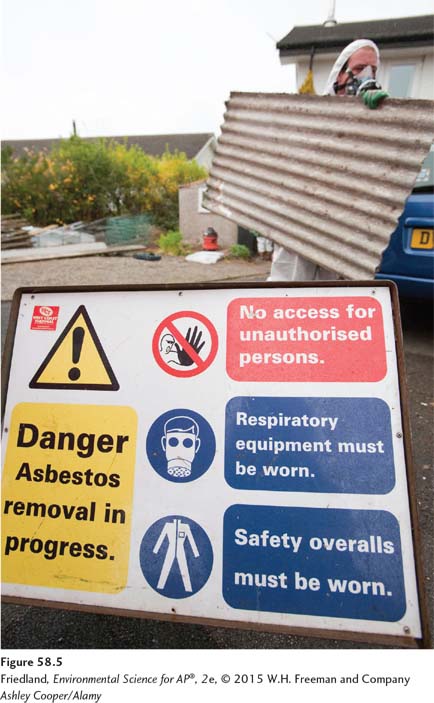module 58 Risk Analysis
Most people face some kind of environmental hazard every day. The hazards we face may be voluntary, as when we make a decision to smoke tobacco, or they may be involuntary, as when we are exposed to air pollution. When assessing the risk of different environmental hazards, regulatory agencies, environmental scientists, and policy makers usually follow three steps for risk analysis: risk assessment, risk acceptance, and risk management. In this module, we will examine each of the three steps.
Learning Objectives
After reading this module you should be able to
explain the processes of qualitative versus quantitative risk assessment.
understand how to determine the amount of risk that can be tolerated.
discuss how risk management balances potential harm against other factors.
contrast the innocent-
until- proven- guilty principle and the precautionary principle.
Risk assessment estimates potential harm
Environmental hazard Anything in the environment that can potentially cause harm.
As illustrated in FIGURE 58.1, risk assessment is the first of the three steps involved in risk analysis. Risk analysis seeks to identify a potential hazard and determine the magnitude of the potential harm. There are two types of risk assessment—

We generally make qualitative judgments in which we might categorize our decisions as having low, medium, or high risks. When we choose to slow down on a wet highway or to buy a more expensive car because we feel it is safer, we are making qualitative judgments of the relative risks of various decisions. We are making judgments that are based on our perceptions but that are not based on actual data. It would be unusual for us to consider the actual probability—
In the United States, the probability of death from various hazards can be calculated from data kept by the government. By looking at the total number of people who die in a year and their causes of death, researchers are able to determine the probability that an individual will die from a particular cause. FIGURE 58.2 provides current data on causes of death in the United States. Because these risk estimates are based on real data, they are quantitative rather than qualitative. If we examine this figure, we see that the probability of dying in an automobile is far greater than the probability of dying in an airplane. Similarly, the probability of dying from heart disease is monumentally greater than the risk of dying in a pedestrian accident. These numbers underscore the fact that our perceptions of risk can often be very different from the actual risk. Because a catastrophic event, such as a nuclear plant meltdown or a plane crash, can do a great deal of harm and receives great media attention, people believe that it is very risky to use nuclear reactors or to fly in airplanes. However, as these events rarely occur, the risk of harm is low. In contrast, we tend to downplay the risk of activities that provide us with cultural, political, or economic advantages such as drinking alcohol or working in a coal mine.

Quantitative Risk Assessment
The most common approach to conducting a quantitative risk assessment can be expressed with a simple equation:
Risk = probability of being exposed to a hazard × probability of being harmed if exposed
Using this equation, we could ask whether it is riskier in a year to fly on commercial airlines for 1,609 km (1,000 miles) per year or to eat 40 tablespoons of peanut butter, which contains tiny amounts of a carcinogenic chemical produced naturally by a fungus that sometimes occurs in peanuts that are used to make peanut butter. The risk of dying in a plane crash depends on the probability of experiencing a plane crash, which is very low, multiplied by the probability of dying if the plane does crash, which approaches 100 percent. The risk of dying of cancer from consuming peanut butter depends on your probability of eating peanut butter, which may be near 100 percent, multiplied by the probability that consuming peanut butter will cause you to develop lethal cancer, which is very low. It turns out that both behaviors produce a 1 in 1 million chance of dying. This example demonstrates a fundamental rule of risk assessment: The risk of a rare event that has a high likelihood of causing harm can be equal to the risk of a common event that has a low likelihood of causing harm.
Quantitative risk assessments bring together tremendous amounts of data. The estimates of harm can come from acute and chronic dose-
A Case Study in Risk Assessment
As we saw in our discussion of water pollution in Chapter 14, from the 1940s to the 1970s some companies manufacturing electrical components dumped PCBs (polychlorinated biphenyls) into rivers. Beginning in the 1960s, there was increasing evidence that PCBs might have harmful health effects on organisms that came into contact with them, including liver damage in animals and impaired learning in human infants.

Once the EPA identified PCBs as a potential hazard, it began a risk assessment. The agency brought together a range of data. First, scientists had to determine which concentrations of PCBs might cause cancer. To accomplish this objective, they examined dose-
The final result of the risk assessment on PCBs showed that the risk from eating contaminated fish is higher than the risk from drinking contaminated water and much higher than breathing contaminated air. As a result, signs were posted on the Hudson River and at Silver Lake instructing anglers not to consume any fish they caught (FIGURE 58.3). With limited fish consumption, the EPA concluded that the absolute risk of an individual developing cancer from PCB exposure was low. However, the risk was high enough to cause the EPA to recommend a dredging of the Hudson River to remove a large fraction of the PCBs that had settled at the bottom of the river (see Chapter 14).
Risk acceptance determines how much risk can be tolerated
Once the risk assessment is completed, the second step in risk analysis is to determine risk acceptance—
Risk management balances potential harm against other factors
Risk management, the third step of the risk-
The regulation of arsenic in drinking water provides an excellent example of the difference between risk assessment and risk management. As we saw in Chapter 14, despite the fact that scientists knew that 50 ppb of arsenic could cause cancer in people, from 1942 to 1999 the federal government set the acceptable concentration of arsenic at 50 ppb. In 1999, the EPA announced it was lowering the maximum concentration of arsenic in drinking water to 10 ppb, which matched the standards set by the European Union and the World Health Organization. This regulation threatened to place a large financial burden on mining companies that produced arsenic as a by-
Worldwide standards of risk can be guided by two different philosophies
Innocent-
There are currently about 80,000 regulated chemicals in the world but they are not regulated the same way around the globe. A key factor determining the type of chemical regulation is whether the regulations are guided by the innocent-

Precautionary principle A principle based on the belief that action should be taken against a plausible environmental hazard.
In contrast, the precautionary principle is based on the belief that when a hazard is plausible but not yet certain, we should take actions to reduce or remove the hazard. The plausibility of the risk cannot be speculation; it must have a scientific basis. In addition, the intervention should be in proportion to the potential harm that might be caused by the hazard. This approach allows fewer harmful chemicals to enter the environment. However, if the initial assessment indicates a plausible risk and the chemical ultimately proves harmless but beneficial, its introduction can be delayed for many years. Moreover, the slower pace of approval can reduce the financial motivation of manufacturers to invest in research for new chemicals. In short, there is a trade-

The benefit of the precautionary principle can be illustrated using the case of asbestos. Asbestos is a white, fibrous mineral that is very resistant to burning. This made asbestos a popular building material throughout much of the twentieth century. It is now widely accepted that dust from asbestos can cause a number of deadly diseases including asbestosis (a painful inflammation of the lungs) and several types of cancer. When asbestos was first mined in 1879, there was no evidence that it harmed humans. The first report of deaths in humans was in 1906 and the first experiment showing harmful effects in rats was conducted in 1911. In 1930, it was reported that 66 percent of workers in an asbestos factory suffered from asbestosis. In 1955, researchers found that asbestos workers had a higher risk of lung cancer than other groups. In 1965, a study linked a rare form of cancer with workers who were exposed to asbestos dust. Despite all of the growing scientific evidence that asbestos was harming human health, little was done to reduce the exposure of workers and the public. Indeed, it was not until 1998 that the European Union banned asbestos. Today, workers go to great lengths not to be exposed to asbestos dust such as by wearing protective suits and using respirators (FIGURE 58.5). A study in the Netherlands estimated that had asbestos been banned in 1965 when the harm to health became clear, the country would have had 34,000 fewer deaths from asbestos and would have saved approximately $25 billion in cleanup and compensation costs. Because the effects of asbestos can take several decades to harm a person’s health, the European Union estimates that from 2005 to 2040 it will have 250,000 to 400,000 additional people die as a result of past exposures to asbestos. Had the European Union been using the precautionary principle decades earlier, the number of deaths would have been considerably less.
International Agreements on Hazardous Chemicals
Stockholm Convention A 2001 agreement among 127 nations concerning 12 chemicals to be banned, phased out, or reduced.
In 2001 a group of 127 nations gathered in Stockholm, Sweden, to reach an agreement on restricting the global use of some chemicals. The agreement, known as the Stockholm Convention, produced a list of 12 chemicals to be banned, phased out, or reduced. These 12 chemicals came to be known as the “dirty dozen” and included pesticides such as DDT, industrial chemicals such as PCBs, and certain chemicals that are by-
REACH A 2007 agreement among the nations of the European Union about regulation of chemicals; the acronym stands for registration, evaluation, authorization, and restriction of chemicals.
In 2007, the 27 nations of the European Union put into effect an agreement on how chemicals should be regulated within the European Union. Known as REACH, an acronym for registration, evaluation, authorization, and restriction of chemicals, the agreement embraces the precautionary principle by putting more responsibility on chemical manufacturers to confirm that chemicals used in the environment pose no risk to people or the environment. This regulation was enacted because many chemicals used for decades in the European Union had not been subjected to rigorous risk analyses. The new regulations are being phased in over 11 years to permit sufficient time for chemical manufacturers to complete the required testing.